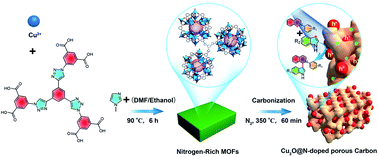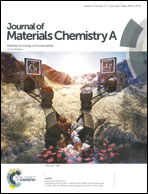Engineering an N-doped Cu2O@N–C interface with long-lived photo-generated carriers for efficient photoredox catalysts†
Abstract
Enhancing the separation efficiency of electrons and holes plays an important role in improving photocatalysis. One of the most effective methods for this is to engineer suitable interface materials. We develop a simple two-step strategy to engineer a N-doped Cu2O@N–C interface using N-rich MOFs (NTU-105) as templates. The presence of N-rich ligands (H6−1) in well-defined cubic MOFs allows the formation of a N-doped porous C matrix hosting well-dispersed N-doped Cu2O. This nanostructure provides several favorable features for photocatalysis: (1) the porous C matrix substrate effectively stabilizes the small Cu2O nanoparticles, preventing their aggregation; (2) the N doping of Cu2O and the C substrate increases their conductivity, which can enhance electron and hole transfer properties; and (3) the uniform distribution of N-doped Cu2O nanoparticles provides abundant highly active catalytic sites. As a result, the N-doped Cu2O@N–C (MCNC) nanoparticles exhibit extraordinary photoredox catalysis in C–C bond forming reactions. Femtosecond transient absorption spectroscopy was used to trace the charge carrier dynamics in the N-doped Cu2O@N–C nanoparticles, revealing the fact that high photocatalytic performance relies on long-lived holes.



 Please wait while we load your content...
Please wait while we load your content...